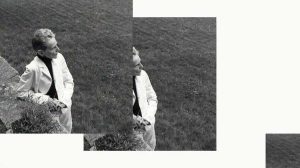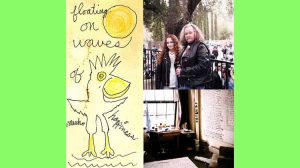
What we are attracted to can sometimes intimidate or unsettle us. In the case of art and writing, the work we find powerful demands our attention, sometimes even a second encounter. Poets may shock us with difficult evocations, or flood us with surprising thoughts and emotions. Poet Richard Siken and artist Ann Gale both provide the opportunity for discomfort and curiosity when experiencing their body of work, often drawn in with a lingering curiosity, perhaps almost a macabre fascination (“what is this and what does it mean?”).
Siken and Gale are parallel creators with a varied but complex body of work. Ann Gale is described as a figurative painter, but a first glance at her paintings conjures up both impressionistic and expressionistic techniques. Her paintings are generally of a single subject, with the kind of staging or composition one is accustomed to seeing for portraiture: a person locked in place, standing or sitting or laying down; a fixed expression; a backdrop of ambiguous, muddy detail. A quick glance through Gale’s body of work is readily available on the internet, and one sees portraits, the kind of paintings that, from a distance, can appear realistic and simple.
A closer look shows that these static images are anything but: the backgrounds and subjects themselves are a complex patchwork of varied colors and textures. These patches intend to express “the changing light and the shifting position[s] of her models over time.”1 In one particular piece, Gale painted her husband reclined in a bathtub full of water. In an article with Art Ltd./West Coast Art + Design, Richard Speer notes that the “transition of warm water to lukewarm to cold is evinced in his expression, which is not that of a happy camper. The artist, however, is not interested in the chipper personae her subjects don for the world-at-large[,] but in deeper, dourer selves that more honestly express the physical and physic depreciation that accrue over time.”2
Richard Siken, as a poet, explores the “deeper” and “dourer” inner self with his collection of poems Crush. His work is genuine, darkly emotional, and undeniably raw. Like Gale, Siken explores themes of brutal truthfulness by speaking unapologetically of the “way it is.” In his poem “Wishbone,”3 Siken writes:
I took the bullet for all the wrong reasons, I’d just as soon kill you myself,
I say. You keep saying, I owe you, I owe . . . but you say the same thing
every time. Let’s not talk about it, let’s just not talk.
Not because I don’t believe it, not because I don’t want it any different, but I’m
always saving and you’re always owing and I’m tired of asking to settle
the debt. Don’t bother. You never mean it
anyway, not really, and it only makes me that much more ashamed.
There is a sincerity in the way Siken and Gale interact with their subjects: harshly, sometimes almost clinically, but with an interest in conveying the absolute truth, despite the discomfort of a bathtub growing cold, or a debt never to be repaid. Gale is said to sit with her subjects for three-hour sessions anywhere from four to twenty-four months in total; her processing of painting is long enough and in such close proximity that Gale is rumored to sometimes put in earplugs to ignore the “gabby” ones.4 Richard Siken’s poetry reads with scrutiny and painstaking attention to detail, a poet’s hyperrealism of situations we can only infer from his work, or which reach out to speak to snapshots of our own lives. Neither artist nor poet is interested in synthesizing their experiences for the sake of making something that is merely “beautiful.”5 Of course, the irony is that both artists have work full of beauty and truth in equal measure.
Richard Siken’s work as a poet is powerful and haunting, but with a relatively small body of work, it is challenging to draw any large conclusions. The collection Crush contains only 21 poems, with irreverent titles such as “Litany in Which Certain Things Are Crossed Out”6 or “A Primer for the Small Weird Loves.” Though the recipient of numerous awards for his work (including the Pushcart Prize, a fellowship for the National Endowment of the Arts, and others ), as well as having the prestige of Yale as the publisher for his collection (Volume 99 of the Yale Series of Younger Poets7 ), Crush is one of just two published collections of Siken’s work, with War of the Foxes published by Copper Canyon Press in 2015. Professionally, Siken is a full-time social worker and an editor for Spork Press.8
But Siken’s poetry demands close reading to soak in the gravity of his chosen imagery and what he is trying to say. Siken’s work often demands a second reading–like a double-glance out a window at something uncomfortable, something macabre you’re not quite sure whether you saw or not. The beauty of Siken’s work is that the dead body you think you saw is actually there.
From “Little Beast”:
The radio aches a little tune that tells us the story of what the night
is thinking. It’s thinking of love.
It’s thinking of stabbing us to death
and leaving our bodies in a dumpster.
That’s a nice touch, stains the night, whiskey and kisses for everyone.
Tonight, by the freeway, a man eating fruit pie with a buckknife
carves the likeness of his lover’s face into the motel wall. I like him
and want to be like him, my hands no longer an afterthought.
Later, in the same poem:
The fact of his pulse
the way he pulled his body in, out of shyness or shame or a desire
not to disturb the air around him.
Everyone could see the way his muscles worked,
the way we look like animals,his skin barely keeping him inside.
I wanted to take him home
and rough him up and get my hands inside him, drive my body into his
like a crash test car.
Siken has “the darkness” in his work. It exists in the image of a crash test car being driven into a handsome man; into the carving of a fruit pie with a buckknife, and in a thousand beautiful moments that are also, horrific. Without heavy-handed metaphors forcing the poems into gothic shackles, the beauty of Siken’s work is that the ennui and horror exist in the re-imagining of the day-to-day, as unfolded by a sincere, obsessive-but-dark narrator.
Similarly, Gale’s work plays with the idea of of the mundane being a little on the ugly and macabre side: her works have palpable ennui and mood, which emanates possibly from the color palette (predominantly grey, brown, and neutral/natural tones) but also the posing of the subjects themselves. In Gary, the 2005 painting acquired by the Portland Art Museum, the positioning of the model is brutal: Gary sits in a chair, wrist turned inward uncomfortably, shoulders slumped, knees together pushing his genitalia awkwardly up and forward between his thighs. There is a sense of discomfort here that makes the viewer want to shift in their own seat for relief, a feat that Silken’s poetry also accomplishes.
What feels uncomfortable in Gale’s work is also a sense of multi-point observation, an almost claustrophobic gaze from the creator. As with any artist who alters a situation by simply existing, how can Gale not be influencing the mood and general feeling of the painting, not only as the hand of the artist, but also as the person sitting mere feet away from another human, for months on end?
Reading Siken slowly, one senses mourning or loss, obsolescence, and cynicism toward the human condition, but at a rapid rate: there is almost a panic that radiates from his pacing. These emotions are all key themes to Siken’s work. And where there is urgency in Richard Siken’s voice, there is claustrophobia in the art of Ann Gale, both thematic emotive devices that quicken our pulse, make us readjust in our seats, check the locks on the doors, perhaps perspective on the work set out in front of us. Gale extracts the emotions from her subjects via her unwavering gaze and practiced craft. Both are obsessed with showing us reality, holding our chins as we are forced to look hard at what makes us uncomfortable. Insomuch as this is an unavoidable part of experiencing both Siken and Gale’s work, it’s impossible to look away.
Richard Siken’s words and Ann Gale’s images lure us with their beauty, whilst paving the way for truthfulness (however ugly or intense it may be) to shine through. In their respective works, the metaphor of a train wreck or car accident is both apt and not enough to convey how these themes take their toll on us, as readers/viewers: we are startled and quieted, seduced, and rejected. We cannot take our eyes off of the subjects because they are equally unsettling and picturesque.
Works Cited
1 “Wikipedia: Ann Gale.” http://en.wikipedia.org/wiki/Ann_Gale
2 “Profile of Ann Gale by Richard Speer in Art, Ltd.” http://www.richardspeer.com/artltdanngale.html
3 Siken, Richard. Crush. Yale University Press (New Haven), 2005.
4 “Profile of Ann Gale by Richard Speer in Art, Ltd.” http://www.richardspeer.com/artltdanngale.html
5 Barrett, Terry. Criticizing Art: Understanding the Contemporary. Mayfield Publishing Company (Mountain View), 1994.
6 “Apostrophe Cast: Richard Siken.” http://www.apostrophecast.com/authors/richardsiken.html
7 “Wikipedia: Richard Siken.” http://en.wikipedia.org/wiki/Richard_Siken
8 “Wikipedia: Spork.” http://en.wikipedia.org/wiki/Spork_Press





Leave a Reply